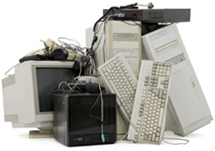TECHLOGIC UNIT II , E-Waste Recycling
Techlogic Unit II the extention of Techlogic has acquired the authorization from the Karnataka pollution control board as well as central pollution control board to perform the E-waste Recycling Activity..
TECH LOGIC was formed in 2004 with a vision of providing complete solution for storage devices in the computing world. We have an office area of 8000 sq.ft. at a prime location in the Silicon Valley of India - Bangalore. Apart from the Bangalore office, we have office in Chennai and affiliates overseas with branches in Italy, Mexico, Nigeria, Iran, and the USA.
TECHLOGIC is primarily focused on repair activities of all IT products. We have over 8 years experience in data recovery (http://www.techlogicindia.com) in both logical and physical recoveries,storage drive repairs like hard disk drives, DAT, DLT, SDLT, LTO’s, Ultrium drives, Tape Libraries and networking products, servers, systems and laptop servicing. We have constantly improved our operations with continued training as well as research and development of new techniques to keep us one step ahead of the competition.
As per Hazardous Waste (Management Handling & Transboundry Movement) Rules,2008 Schedule-1V Components of waste electrical and electronic assembles comprising accumulators and other batteries which also include mercury-switches, activated glass gullets from cathode-ray tubes and other activated glass and PCB-capacitors, or any other component contaminated with Schedule 2 constituents (e.g. cadmium, mercury, lead, polychlorinated, biphenyl) to an extent that they exhibit hazard characteristics.
Indian Scenario:
Sixty-five cities in India generate more than 60% of the total e-waste generated in India. Ten states generate 70% of the total e-waste generated in India. Maharashtra ranks first followed by Tamil Nadu, Andhra Pradesh, Uttar Pradesh, West Bengal, Delhi, Karnataka, Gujarat, Madhya Pradesh and Punjab in the list of e-waste generating states in India. Among top ten cities generating e-waste, Mumbai ranks first followed by Delhi, Bangalore, Chennai, Kolkata, Ahmadabad, Hyderabad, Pune, Surat and Nagpur. There are two small e-waste dismantling facilities are functioning in Chennai and Bangalore. There is no large scale organized e-waste recycling facility in India and the entire recycling exists in unorganized sector.

What is E-waste ?
e-wasteElectronic Waste – or e-waste – is the term used to describe old, end-of-life electronic appliances such as computers, laptops, TVs, DVD players, mobile phones, mp3 players etc. which have been disposed of by their original users. While there is no generally accepted definition of e-waste, in most cases, e-waste comprises of relatively expensive and essentially durable products used for data processing, telecommunications or entertainment in private households and businesses.
Public perception of e-waste is often restricted to a narrower sense, comprising mainly of end-of-life information- & telecommunication equipment and consumer electronics. However, technically, electronic waste is only a subset of WEEE (Waste Electrical and Electronic Equipment). According to the OECD any appliance using an electric power supply that has reached its end-of-life would come under WEEE. In this web-based E-Waste Guide we define all appliances running on electricity.
Sources Of E-Waste:
IT and Telecom Equipments
Large Household Appliances
Small Household Appliances
Consumer and Lighting Equipments
Electrical and Electronic Tools
Toys, Leisure and Sports Equipment
Medical Devices
Monitoring and Control Instruments
PC industry is growing at a 25% compounded annual growth rate. The e-waste inventory based on this obsolescence rate and installed base in India for the year 2005 has been estimated to be 146180.00 tonnes. This is expected to exceed 8,00,000 tones by 2012. There is a lack of authentic and comprehensive data on e-waste availability for domestic generation of E-waste and the various State Pollution Control Boards have initiated the exercise to collect data on e-waste generation.
Benefits From Repair And Reuse Of E-Waste:
we can save up to some extent of the manufacturing cost of IC’s
we can stop some extent digging the earth for mining purpose
we can save our environment from the pollution by reusing old parts
we can help the companies to run there business smoothly by repairing there old IT products.
cost cutting for companies by repairing there old IT product
Valuables in E-Waste:
Electronics goods are composed of different materials, often of high value. Gold, platinum, silver, copper, etc. are valuable materials which recyclers recover from e-waste.
Composition Of E-Waste:
It contains more than 1000 different substances, which fall under “hazardous” and “non-hazardous” categories. Broadly, it consists of ferrous and nonferrous metals, plastics, glass, wood & plywood, printed circuit boards, ceramics, rubber and other items. Iron and steel constitutes about 50% of the e-waste followed by plastics (21%), non ferrous metals (13%) and other constituents. Nonferrous metals consist of metals like copper, aluminum and precious metals ex. silver, gold, platinum, palladium etc. The presence of elements like lead, mercury, arsenic, cadmium, selenium, and hexavalent chromium and flame retardants beyond threshold quantities in e-waste classifies them as hazardous waste.
